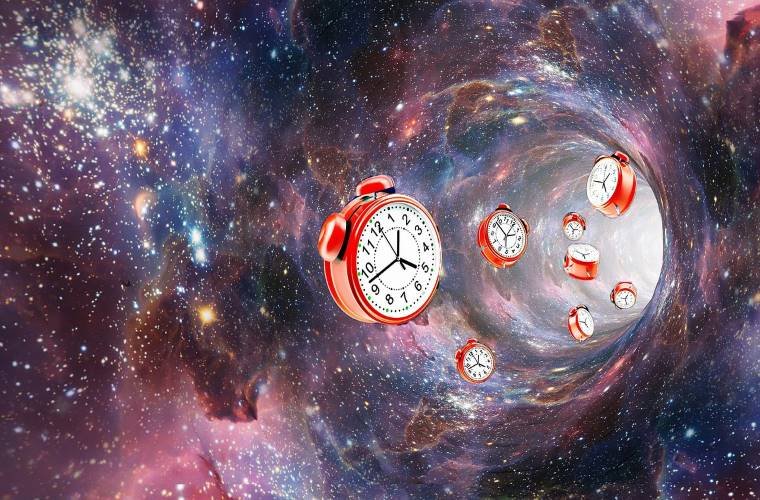Time travel may be possible after all, particularly in the quantum realm. And based on recently published research, this may include moving both backward and forward in time.
BACKGROUND: BUT ISN’T TIME TRAVEL IMPOSSIBLE?
In classical physics, the movement of time is more or less described as a movement from a more organized state to a less organized state. Physicists called this entropy. Such movement can be seen in everyday systems like the rotting of food or the growing of a tree, or the simple process of a meal cooking on the stove.
Due to this seeming unidirectional aspect to the movement of time, often called time’s arrow, most physicists agree that traveling backwards in time would violate a number of known processes and properties of physics, likely making it all but impossible outside of science fiction.
By comparison, moving forward in time is relatively straightforward. Simply speed up to as close to the speed of light as possible, thereby taking advantage of the relativistic effects that will cause time on the outside world to travel significantly faster than it will for you. In short, if you travel close enough to the speed of light, you will age significantly slower than the world around you, meaning that for all intents and purposes, you will have traveled into the future.
Now, based on new research published in the journal Communications Physics, traveling to the past may be back on the proverbial time travel table.
ANALYSIS: TO TRAVEL BACKWARDS YOU FIRST MUST GO QUANTUM
According to a recent press release; “a team of physicists from the Universities of Bristol, Vienna, the Balearic Islands and the Institute for Quantum Optics and Quantum Information (IQOQI-Vienna), has shown how quantum systems can simultaneously evolve along two opposite time arrows – both forward and backward in time.”
This unique ability is governed by the quantum principle of superposition, where a single particle of matter can exist in two different states at the same time. According to the researchers behind the latest study, this unique state of matter also allows for the travel of time in both directions, forward and backward.
“We can take the sequence of things we do in our morning routine as an example,” said the study’s lead-author Dr. Giulia Rubino from the University of Bristol’s Quantum Engineering Technology Labs (QET labs). “If we were shown our toothpaste moving from the toothbrush back into its tube, we would be in no doubt it was a re-winded recording of our day. However, if we squeezed the tube gently so only a small part of the toothpaste came out, it would not be so unlikely to observe it re-entering the tube, sucked in by the tube’s decompression.”
“Extending this principle to time’s arrows,” added Rubino, “it results that quantum systems evolving in one or the other temporal direction (the toothpaste coming out of or going back into the tube), can also find themselves evolving simultaneously along both temporal directions.”
Basically, if this quantum sized hypothetical “toothpaste” can evolve along two different paths as allowed by superposition, then it is possible that one of those paths results in the toothpaste moving back into the tube, essentially going back in time to a previous, less entropic state. According to Rubino, it is precisely this process that his team’s research shows.
“In our work, we quantified the entropy produced by a system evolving in quantum superposition of processes with opposite time arrows,” explained Rubino. “We found this most often results in projecting the system onto a well-defined time’s direction, corresponding to the most likely process of the two.”
In short, most of the time things moved forward in time, just as researchers and classical physics would predict. However, sometimes the opposite happened.
“And yet,” he added, “when small amounts of entropy are involved (for instance, when there is so little toothpaste spilled that one could see it being reabsorbed into the tube), then one can physically observe the consequences of the system having evolved along the forward and backward temporal directions at the same time.”
In conclusion, based on the size and timing of the event, the quantum realm may possess its own equivalent of a five second rule, allowing the movement back in time to a less entropic state in certain circumstances. But what does this mean in the macro world?


OUTLOOK: SO FLUX CAPACITOR OR NO FLUX CAPACITOR?
Like many things that occur in the quantum realm, the findings of this latest research may be counter-intuitive. However, the researchers behind the study say it is a real, actual principle operating inside the quantum world that may have real, macro-world level impacts.
“Although this idea seems rather nonsensical when applied to our day-to-day experience, at its most fundamental level, the laws of the universe are based on quantum-mechanical principles.”
This revelation also likely means that macro level systems that are affected by processes in the quantum realm, like the ability of birds to sense the Earth’s magnetic field using a quantum mechanical process, may be able to take advantage of these uniquely quantum effects. Apparently, this now includes time travel.
“Although time is often treated as a continuously increasing parameter, our study shows the laws governing its flow in quantum mechanical contexts are much more complex,” said Rubino. ”This may suggest that we need to rethink the way we represent this quantity in all those contexts where quantum laws play a crucial role.”
Okay, somebody call Doc Brown. Anyone seen the keys to my DeLorean?
Follow and connect with author Christopher Plain on Twitter: @plain_fiction

